Your quad is a do-anything machine. ATV’s are great for getting things done and for recreation too. But now you’re looking at your tires. Maybe you’ve blown one or they’re getting bald. Or maybe you just want a more aggressive tread pattern and a bigger tire. The problem is you’re a little lost when it comes to your ATV tire size.
How big can you go? Should you go big? How do you even know what all these numbers represent?
Don’t worry, we’ve got you covered. We’ll answer all those answers and more in this comprehensive guide.
How Do You Read ATV Tire Sizes?So, you’re shopping around for tires and you see one listed with a size like 26×10-12. Or, worse yet, you find something listed like 206/80R12.
What the heck does all that mean?
First, you need to figure out if you’re dealing with standard or metric ATV tire sizes.
ATV Tire Sizes: Standard Tire Sizing ChartStandard format is much more common on ATV tires than metric. You might see a tire size written 26×10-12 or, occasionally, 26x10x12. This format is pretty straightforward. It uses three numbers to sum up the size:
If you see a tire size that looks like this: 205/80R12, you know you’re dealing with metric. The metric format is exceedingly rare for ATVs and odds are you’ll never come across it. But if you do, the letter thrown in the middle of those numbers is a dead giveaway. In metric, you always have three numbers and a letter:
There may be other numbers and letters before and after these, but they’re not important for understanding your ATV tire size.
Breaking Down ATV Tire Sizes by the NumbersKnowing how to read those tire sizes is just the first step. You really need to know how to use them. Is 26 inches a reasonable diameter for your quad? What kind of width do you need?
You really need to know how to use them. Is 26 inches a reasonable diameter for your quad? What kind of width do you need?
When you’re considering replacing all of your tires, you’ll want to make sure you get something that will actually fit on your stock vehicle.
Your typical ATV tire diameter fits within a range of about 20 inches for the smallest machines to about 30 inches for your more factory mud-equipped machines.
Basically, your quad will typically fit into one of few categories:
Keep in mind that you’ll want to keep within a couple inches of your stock tire size. If you go too big, you’ll start to rub on your fenders (among other issues). If you go small—well, that’s just silly.
Tire width is easier to understand. Choosing the right tire width has a lot to do with your own preferences and riding style.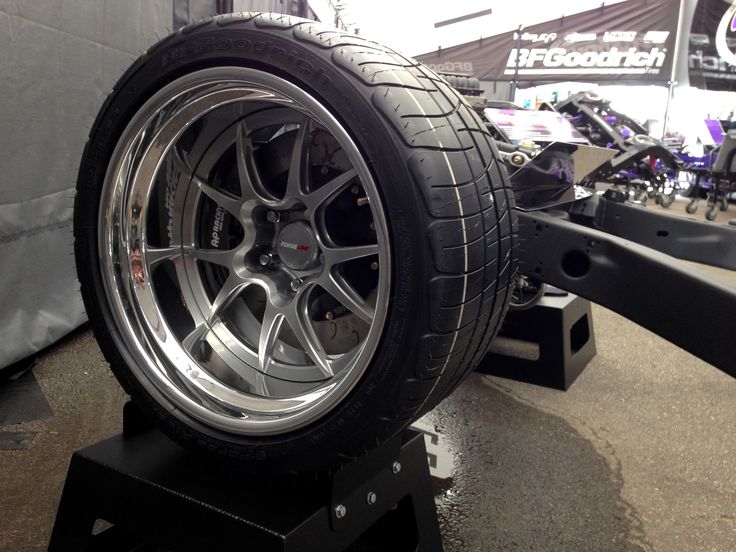
A wider tire tends to give you a flatter tread pattern and more grip. A narrow tire gives you a little more control.
ATV’s usually have a wider tire on the rear than on the front to get the best of both tires. A typical rear tire on a quad will be 10 to 11 inches wide while a front tire will be 7 to 8 inches wide.
But matching your tire width to your riding style isn’t the only thing you need to consider. You also need to make sure it’ll physically fit on your chosen wheel. There are two main ways to make sure it’ll fit.
This one is non-negotiable.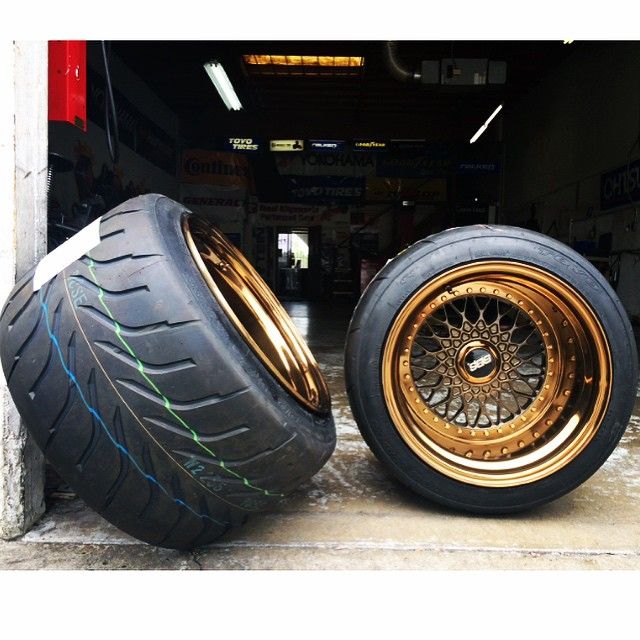 You have to make sure your tire’s wheel diameter matches your actual wheel diameter.
You have to make sure your tire’s wheel diameter matches your actual wheel diameter.
Most off-road wheels tend to be 10 to 12 inches in diameter—which is convenient considering most off-road tires are designed to fit those wheels. That’s a good size as it gives your tire plenty of cushion between the tread and rim, which results in smoother rides and more protection for your rims.
Of course, you can end up with bigger wheels if you have bigger tires, but we’re getting ahead of ourselves.
Choosing the Right Size Tires for Your ATVYou don’t need any old tire. You have to choose the perfect ATV tire size for you. After all, you ride your own way and have your own needs.
We’re going to simplify ride style to three main types:
For a workhorse ATV, it’s not a bad idea to stick with stock. It’ll give you the expected traction and power you need.
Trail riding, like dune riding, means you want to go fast.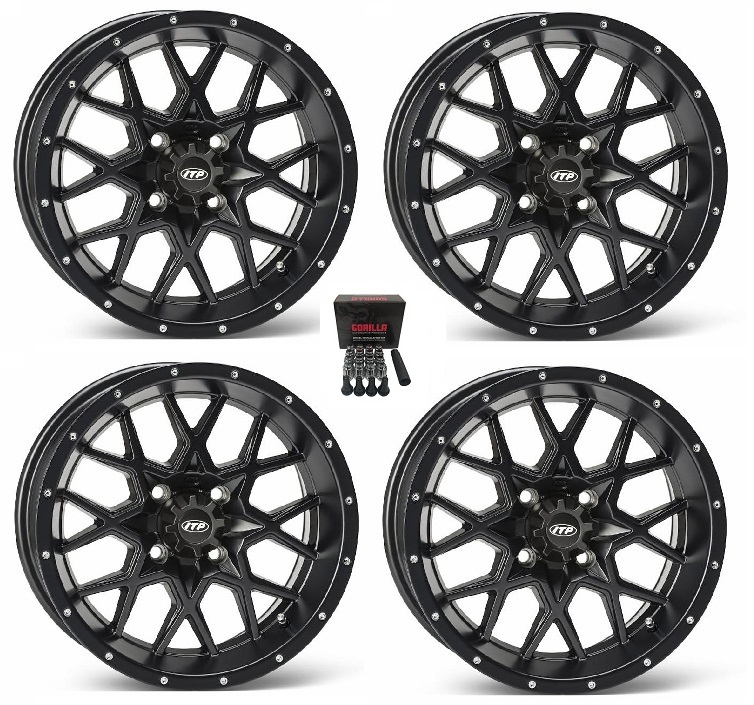 For that, a wider, flatter tire will keep you gripping and in control. If you ride in the mud, you might want to go with something bigger and narrower along with an aggressive tread pattern.
For that, a wider, flatter tire will keep you gripping and in control. If you ride in the mud, you might want to go with something bigger and narrower along with an aggressive tread pattern.Trails and dunes demand high traction, and you get that by going wider. You don’t necessarily need a taller tire, but a wider one will give you the grip you need.
Dominating rock gardens and taking on bounty holes is done best with a big tire. But going big isn’t as simple as just buying the biggest tire you see.
Can I Put Bigger Tires on My ATV?The short answer is yes.
Here comes the long answer.
Every ATV has a theoretical maximum tire size it can fit without modifying the suspension. It’s typically about one to two inches bigger than your stock tires. So if your ATV came with a 27-inch tire, you could probably fit a 29-inch tire without too much trouble.
But what if you want to go bigger?
That takes some work. You’ll either need to invest in a lift kit or some offset A-arms.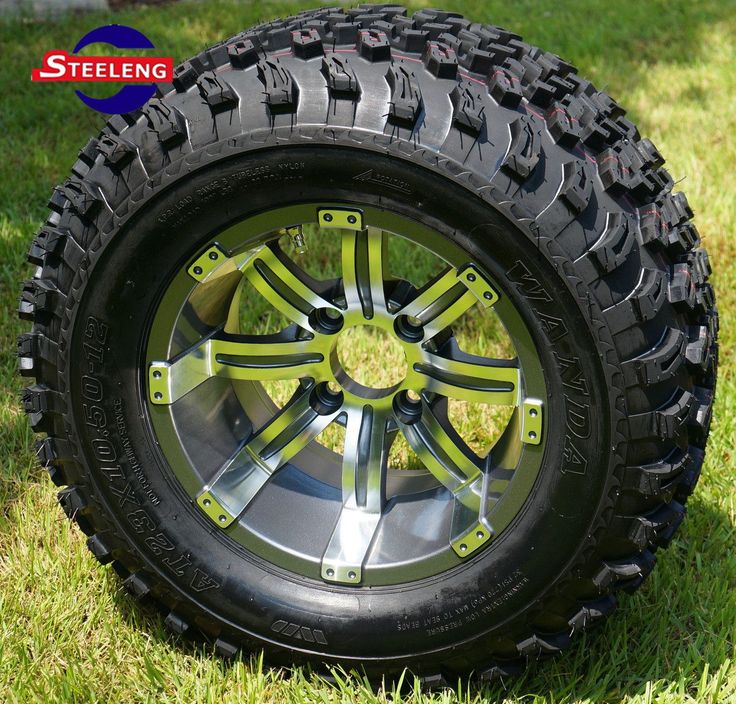 These types of kits will often tell you what the max tire size is when you have them installed.
These types of kits will often tell you what the max tire size is when you have them installed.
You can’t go big without some consequences though. Namely, you’ll lose torque due to the increased diameter (big tires like a high-gear kit!) and the extra weight. The weight can also put extra strain on your clutch and shorten the life of your clutch belt.
Luckily, you can get your torque back with a transmission gear reduction or GDP Portal Gear Lift (which has a gear reduction built in).
You can also bolster your clutch with heavy-duty drive belts and eek out even more torque with a clutch kit.
So now that you’re equipped with knowledge, go equip yourself with some tires. Get the ATV tire size you want, and ride with confidence.
RELATED CONTENT: ATVs37 tires15
Share
10
Example of 8 & 10 inch wide tires on 14x7 rims
Example of 9 & 11 inch wide tires on 14x6 front and 14x8 rear rims
Example of 10 inch wide tires on 7 inch wide rims
Example of an 11 inch wide tire on a 7 inch wide rim
One of the most frequently asked questions we get from our customers is about the width of rims on their ATV or UTV. When you buy our aftermarket rims they are almost always the same width on front and rear which causes some confusion because your OEM rims are 2 different widths. Almost any new ATV or UTV will come with skinnier rims on the front vs. the rears. For example, you would expect to see 12x6 or 14x6 wheels on the front and 12x8 or 14x8 rims on the rear of just about any machine from the factory. Which brings up another question we get all the time. When we tell people the stock rim sizes on their machine are 12x6 (or 14x6) fronts and 12x8 (or 14x8) rears they usually disagree with us because they look at their tire sizes and it makes them think their rims are wider than they actually are. When you read the tire sizes on your machine it would read something like this, 25x8-12 for the front and 25x10-12 for the rear. This makes many people think their front rims are 8 inches wide and their rear rims are 10 inches wide but that is not the case! Nowhere in the tire size does it tell you what width your rims are.
When you buy our aftermarket rims they are almost always the same width on front and rear which causes some confusion because your OEM rims are 2 different widths. Almost any new ATV or UTV will come with skinnier rims on the front vs. the rears. For example, you would expect to see 12x6 or 14x6 wheels on the front and 12x8 or 14x8 rims on the rear of just about any machine from the factory. Which brings up another question we get all the time. When we tell people the stock rim sizes on their machine are 12x6 (or 14x6) fronts and 12x8 (or 14x8) rears they usually disagree with us because they look at their tire sizes and it makes them think their rims are wider than they actually are. When you read the tire sizes on your machine it would read something like this, 25x8-12 for the front and 25x10-12 for the rear. This makes many people think their front rims are 8 inches wide and their rear rims are 10 inches wide but that is not the case! Nowhere in the tire size does it tell you what width your rims are. When you read 25x8-12 on your tire you know that your tire is 25 inches tall and 8 inches wide and it's installed on a rim that is 12 inches in diameter. The width of your rim is still unknown without measuring it or taking our word for it. If your OEM front tires are 25x8-12 they are most likely mounted on 12x6 OEM rims. And the same goes for the rear, if your rear OEM tires say 25x10-12 they are most likely installed on 12x8 OEM rims. Typically your rims will be 1-2 inches skinnier than the width of your tires, sometimes more.
When you read 25x8-12 on your tire you know that your tire is 25 inches tall and 8 inches wide and it's installed on a rim that is 12 inches in diameter. The width of your rim is still unknown without measuring it or taking our word for it. If your OEM front tires are 25x8-12 they are most likely mounted on 12x6 OEM rims. And the same goes for the rear, if your rear OEM tires say 25x10-12 they are most likely installed on 12x8 OEM rims. Typically your rims will be 1-2 inches skinnier than the width of your tires, sometimes more.
Now back to the original question... if my stock rims are 2 different widths can I buy aftermarket rims that are all 4 the same? And will they work with my current tires? The answer is YES! Just because your machine came stock with 2 different widths of rims does not mean that you have to keep that staggered fitment when you buy new rims. You can buy new rims that are all the same width like a 12x7 or a 14x7 and you can install tires on them that are all 4 the same or they can be different widths.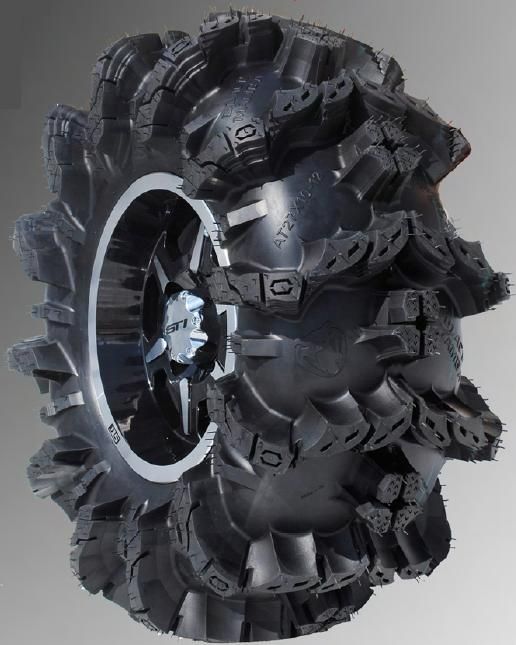 A general rule of thumb is to try and keep your rims about 1-4 inches skinnier than the width of your tires. If you have 26x9-12 front tires and 26x11-12 rear tires you would want to find 12x7 front rims and 12x7 or 12x8 rear rims. Either would work just fine. The same goes for the 14 inch sizes. If you have 26x9-14 front and 26x11-14 rear tire sizes you would want to find 14x7 rims for all 4 or 14x7 fronts and 14x8 rears. As you shop for new rims you will find that most aftermarket rims are only offered in 7 inch widths. It's not as common to find aftermarket rims that are offered in 2 different widths. People get really hung up on this because it seems confusing but it really isn't if you follow the counsel we have given in this article. The bottom line is that if all 4 of your rims are the same, whether they be 12x7, 14x7, 15x7 and so on, you can install 8, 9, 10 or 11 inch wide tires on them. You can install 8 inch wide front tires and 10 inch wide rear tires if you want. You can install 9 inch wide front tires and 11 inch wide rear tires if you want.
A general rule of thumb is to try and keep your rims about 1-4 inches skinnier than the width of your tires. If you have 26x9-12 front tires and 26x11-12 rear tires you would want to find 12x7 front rims and 12x7 or 12x8 rear rims. Either would work just fine. The same goes for the 14 inch sizes. If you have 26x9-14 front and 26x11-14 rear tire sizes you would want to find 14x7 rims for all 4 or 14x7 fronts and 14x8 rears. As you shop for new rims you will find that most aftermarket rims are only offered in 7 inch widths. It's not as common to find aftermarket rims that are offered in 2 different widths. People get really hung up on this because it seems confusing but it really isn't if you follow the counsel we have given in this article. The bottom line is that if all 4 of your rims are the same, whether they be 12x7, 14x7, 15x7 and so on, you can install 8, 9, 10 or 11 inch wide tires on them. You can install 8 inch wide front tires and 10 inch wide rear tires if you want. You can install 9 inch wide front tires and 11 inch wide rear tires if you want.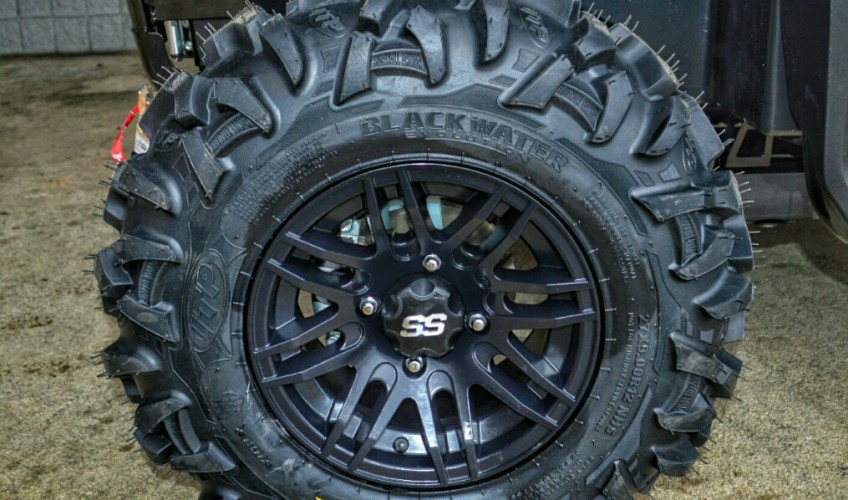 You could install 10 inch wide tires all the way around if you want. Your rims do not have to be different widths just because your tires may be different widths from front to rear.
You could install 10 inch wide tires all the way around if you want. Your rims do not have to be different widths just because your tires may be different widths from front to rear.
Another thing to think about to help you understand this is that your tires must be wider than the rims for them to seat properly. Think about that for a second, if you were to install a tire that is 8 inches wide onto a rim that is also 8 inches wide you would have zero protection for your rim edge. The lip of your rim would be exposed so as you fly down the trail you could easily hit a rock or a stump and mess up your rim. Also, the tire would not seat properly and when you make a hard turn or hit a bump just right your tire could easily pop off the bead of the rim. But if your tire is wider than the rim by at least 1 inch (I prefer 2 when possible) than your tire is seated on the rim properly and has plenty of overhang on either side to help protect the rim edge and keep the tire in position where it belongs on the rim bead.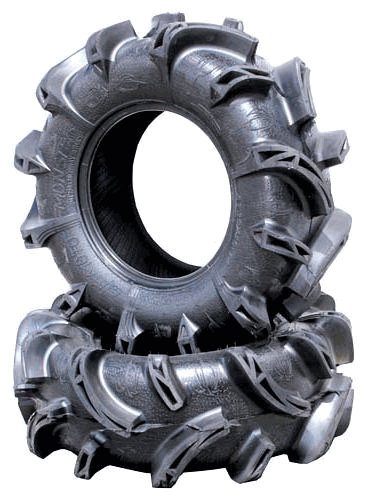 If you are still struggling with this information and you want to discuss further please feel free to call or text us and we'd be happy to help clarify.
If you are still struggling with this information and you want to discuss further please feel free to call or text us and we'd be happy to help clarify.
A four-wheeler is an off-road vehicle by definition, which means that tires for a ATV are the most important part that ensures its flotation. Going to conquer the next track, you must be confident in your four-wheeler.
Whether racing or riding a quad over rough terrain, you can count on a safe and comfortable ride. Experienced riders know that only high-quality ATV tires can provide maximum comfort and safe control of this exciting vehicle.
Given the fact that the ATV was originally destined to conquer the off-road, manufacturers shoe SUVs in tires that provide confident driving on hard dirt roads. Naturally, a car on such wheels can also zip along the highway, although driving on public roads for most models is prohibited by traffic rules.
Even if you are not a professional athlete, you are unlikely to resist the temptation to conquer the viscous wetlands, or test the quad in liquid mud to evaluate its ability to overcome impassable areas. After all, that's what you bought the SUV for. Is not it? And if so, then it is clear that ordinary quad tires are of little use for sorties into the area, replete with deep puddles filled with viscous mud. It's time to think about equipping your ATV with real mud tires.
Real mud tires, unlike standard tires, have larger lugs that can bite into loose soil or sand. The tread, in the form of a discharged Christmas tree, resembles a pattern on tractor wheels. The diameter of such tires is increased and, depending on the model, ranges from 25 to 34 inches.
The most sought after ATV tires are between 26 and 28 inches as they fit most ATVs without any suspension modifications.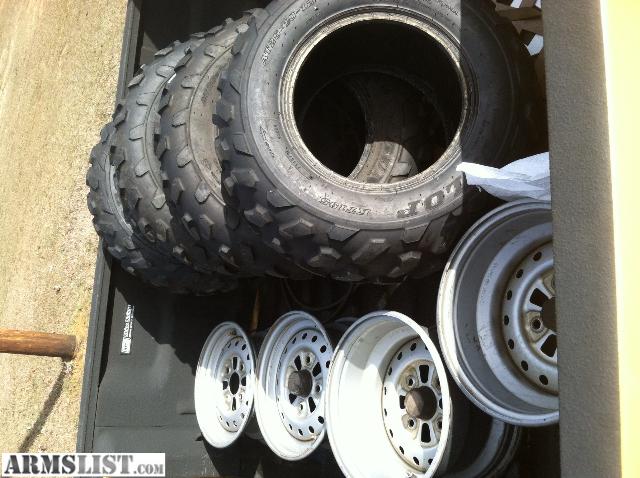 The width of the cross-country tires is slightly larger than the standard tires, and the width of the front and rear tires is different. This allows the front tires to follow their own path, while the rear tires follow a slightly different path, gripping the curb and allowing you to go a lot further.
The width of the cross-country tires is slightly larger than the standard tires, and the width of the front and rear tires is different. This allows the front tires to follow their own path, while the rear tires follow a slightly different path, gripping the curb and allowing you to go a lot further.
Under normal operating conditions, the main parameter that affects the stability and handling of the ATV is the crown - the tread area in contact with the road surface. The larger the contact patch, the better the handling on firm ground. Therefore, if you are a fan of high speeds, like to maneuver and ride on rough terrain full of hard dirt roads, forest rolled roads, as well as any other hard ground, choose tires with a radial cord construction (example 1, example 2, example 3). Also, the radial design of the cord very well fulfills the bumps that can get in your way, a protruding tree root, stone or something else, the radial design will allow you to overcome this bump in the most comfortable way!
Also, the radial design of the cord very well fulfills the bumps that can get in your way, a protruding tree root, stone or something else, the radial design will allow you to overcome this bump in the most comfortable way!
ATV wheels require softer, lighter rubber for maximum road contact and traction to confidently tackle swampy terrain. Cross-country ability is enhanced by a special tire design. An important role belongs to the lamellas, which have a peculiar shape and optimal height. The ability of the lugs to self-clean is very important, since the adhering dirt greatly complicates the patency on loose soils. Sidewall strength is also important for mud tires. Passing elastic wheels on deep ruts is associated with the risk of damage. The presence of strong sidewalls minimizes such risks.
The diameter of the tires affects the ground clearance of the all-terrain vehicle, the increase of which increases its cross-country ability. The width of the tire changes the area of its contact with the road. Wider profiles sink less into soft and loose surfaces, helping you to move confidently through the mud.
Wider profiles sink less into soft and loose surfaces, helping you to move confidently through the mud.
When choosing tires for an ATV, you should proceed from the expected conditions of its operation. Ideally, tires should provide comfortable driving, both on hard dirt roads and in mud. However, in practice it is impossible to achieve such results. Different manufacturers solve this difficult problem in their own way. In principle, all solutions come down to the creation of rubber optimized for use on a certain type of road: solid dirt tracks, or loose soils, mud, sand, grass. There are also all-purpose tires that provide average performance on different surfaces.
|
|
| DAKAR 2016. SERGEY KARYAKIN IN THE QUAD CATEGORY. |
The well-known American manufacturer ITP has succeeded in creating the perfect tire. It is by far the #1 tire and rim brand in its class. ITP products are known and bought by professional riders and extreme sports enthusiasts all over the world. Our well-known compatriot driver Sergey Karyakin participated in the Paris-Dakar race on tires with ITP rims. The ITP range includes the following tire types:
It is by far the #1 tire and rim brand in its class. ITP products are known and bought by professional riders and extreme sports enthusiasts all over the world. Our well-known compatriot driver Sergey Karyakin participated in the Paris-Dakar race on tires with ITP rims. The ITP range includes the following tire types:
ITP tires are produced exclusively in the USA, which is an additional guarantee of their high quality.
The softness of ITP tires is superior to all known brands. But this indicator is very important for off-road driving. In an effort to find the best properties for different roads, ITP tire developers create tires for all conditions of use, creating new and unique treads that can cope with their tasks on any type of surface.
The main advantages of ITP tires include:
Just to add, ITP also makes excellent rims for the ATV in various sizes, including beadlock and reversible beadlocks. The discs are made of durable aluminum alloy and are lightweight and stylish. They are compatible with sport and utility models of modern ATVs.
The discs are made of durable aluminum alloy and are lightweight and stylish. They are compatible with sport and utility models of modern ATVs.
ITP wheels are produced using an original casting technology that provides them with an enviable resistance to deformation and cracking. In the US, ITP provides a lifetime warranty on its discs. The polished surfaces of these wheels go well with the matte color of the tires and give the SUV a touch of special drive.
Equipping your ATV with ITP wheels and tires, you can safely conquer the most difficult tracks on it. It is by far the #1 brand for ATV tires and rims.
Main Page→→
When choosing wheels for an ATV, you, unlike motorcycle wheels, will not depend on the size prescribed by the manufacturer of the ATV. The size and material of the disk here can be changed depending on the needs. Before talking about which ATV rims are best suited to your riding style, it is worth recalling the marking of ATV and UTV rims.
ATV rim marking
Let's demonstrate how to read the disc markings using a specific example: for example, the disc for an ATV has the designations 8x8, 3+5, 4/110. So its diameter, which is indicated in the first digit, is 8 inches. The second number is the inner diameter of the tire, it must match the diameter of the rim.
The next two digits are the offset of the disk, which shows the distance from the mating side of the disk and its conditional middle. At the same time, the marking of the disk on the ATV shows the displacement of the inner and outer sides, the difference between which determines the negative, positive or zero offset of the disk. In our case, the disk overhang is negative and is -2 (3-5=-2). The next figure shows the number of holes in the disc, in our example there are 4. The last designation is the distance between the holes, measured in mm., In our case it is 110 mm.
Choose wheels for ATV
Alloy wheels for ATV have a number of advantages over stamped ones. Let's talk about them so that you can understand whether you need to focus on these pluses or leave stamping on an ATV more appropriate.
Let's talk about them so that you can understand whether you need to focus on these pluses or leave stamping on an ATV more appropriate.
First, the alloy wheels on the ATV can be chosen wider than the standard ones. This, in turn, allows you to install non-standard tires on an ATV that will not get up "donut". On alloy rims, a wide ATV tire will increase the contact patch, which means flotation will increase. However, not only alloy wheels on an ATV solve the problem of increasing the wheel track - spacers for disks are also used for this.
The second advantage for which alloy wheels are chosen for ATVs is the reduction in the weight of the unsprung part of the ATV. ATV races are held in a variety of terrain, including relatively flat ground where speed is important and casting will have a distinct advantage here. In other cases, their disadvantage is emphasized - fragility. However, some manufacturers of ATV wheels, such as ITP, give a lifetime warranty on casting, the very fact of which speaks of great confidence in their products and makes them reconsider their attitude towards alloy wheels.
The third reason, which, oddly enough, also matters is the aesthetic side. Despite the fact that the ATV pursues purely utilitarian or sporting goals, many people like to combine functionality and attractive appearance, which can be achieved by choosing an ATV casting.
In addition, many ATV alloy wheels come with beadlocks, and the latter are simply indispensable when driving on flat tires. As you know, with a decrease in pressure, which is done to overcome off-road, the tires have a tendency to disassemble. The easiest and most reliable way to keep the tire on the rim is to use beadlocks that attach the tire to the rim. Badlocks are a steel ring with holes, in place and in number they are divided into two types: one-sided and two-sided. Moreover, it is usually enough to install a one-sided beadlock on a cast wheel for an ATV, since the load on the inside of the wheel is not large. Only hard off road on fully flat tires requires the installation of reversible beadlocks.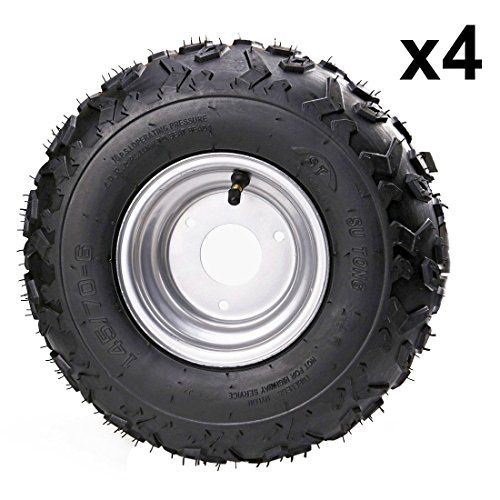
Of course, the use of beadlocks imposes certain restrictions: the speed, as a rule, should not exceed 60 km/h, it becomes much more difficult to balance the wheels with beadlocks, in addition, it is necessary to constantly monitor their condition - clean, tighten. Be that as it may, beadlocks have been produced since the 1980s and Off Road on an ATV is rarely done without. The cast rim and beadlock are welded on, the outer edge of the tire is not put on the rim, but is pressed with a beadlock ring, fixed with a large number of bolts. The inner edge of the tire, if the beadlock is one-sided, is kept as usual on the hump (annular protrusions at the edge of the disk).
ATV Wheel Manufacturers
ATVs are nowhere near the popularity of cars and there aren't as many wheel manufacturers here. They are mainly represented by companies that produce off-road wheels for off-road. One of the leaders in the manufacture of alloy wheels for ATVs is the Canadian company ITP, which is famous for its excellent design and excellent durability of its products.